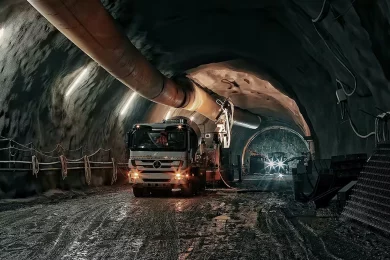Electricity is one of the biggest expenses associated with underground mining. Ventilation often accounts for 25% to 40% of the total energy costs and 40% to 50% of the total energy consumption of a mine operation. Systems used to ventilate underground mines and the total fan power installed in a single mine operation can easily exceed 10,000 kW.
In a recent article published by Insig Technologies, the company argues that investigations of a number of mine ventilation systems have indicated to be, in general, fairly energy inefficient. “A large number of systems operate at efficiencies below 65%. Ventilation is also one of the major health and safety concerns as the level of pollutants and ambient temperature must be maintained within a defined range to minimise negative health outcomes for the people working underground. Due to the need to improve the underground environment, increase production, and minimise the waste of energy, the demand for Ventilation on Demand (VoD) has grown at an intensified rate in the underground mining world.”
Most mining operations operate on continuous rosters working two 12-hour shifts, however, during these shifts there are periods of time when productive work is not performed, and the need for ventilation is much lower. “Two typical and large non-productive times in underground mining are travelling to and from the workplace and exclusion periods for pre and post blasting. During a 12-hour underground work shift up to 20% to 25% of the shift time can be unproductive time for both assets and personnel. The flow of air required to maintain air quality changes as the mine development progresses and significant savings can be realised by adjusting fan speed in line with vehicle emissions, human activities, planned activities and mine configuration.”
Insig Technologies’ Ventilation on Demand (VoD) it says provides a solution that consists of both engineered equipment and software to optimise the new and the older generation ventilation equipment. This product provides one of the key strategic priorities of the Insig Digital Mining Model, through the integration of the equipment intelligence capability with autonomous operation of fixed plant equipment. It provides the first step in developing a full autonomous production VoD system from the physical fan to the intelligent software layer.
“VoD utilises airflow and pressure sensors to monitor the performance and condition of the ventilation system components. Real-time monitoring combined with dynamic fan control provides a more effective underground gas extraction/air circulation process, as areas that are being worked in benefit from better, more efficient ventilation, while areas not being worked in are not ventilated. Overall, this leads to significantly reduced electricity and power consumption costs, whilst also making the underground mine much safer and more productive.”
When integrated with Insig Technologies Environmental Quality Management System (EQMS), a recent trial within an underground mine in WA demonstrated that gas levels dropped to safe levels within 12 minutes after a blast when the remote control of VoD enabled ventilation to be initiated directly after the blast.
VoD offers an all-in-one solution that can either be integrated into the existing client network, or work as a standalone system providing a cloud-based interface for operators to access the critical data from any location. “Sensors are installed at critical points across the ventilation system, with localised PLCs connected via communication cables to establish an extensive underground network. Data is then either sent offsite through a secure cloud connection to allow the front-end display through the fit-for-purpose interface or kept on premises and displayed on on-site server infrastructure. Each solution can be custom designed to ensure it is the best fit possible for each mine site.”
Overall, the cited benefits of the Insig Technologies VoD system are: autonomous operation with complete remote control and monitoring over the underground ventilation system; compatibility with all ventilation systems with the ability to integrate solution in pre-existing on-site hardware; and a cloud-based interface with acquisition of data continuously (opposed to weekly or fortnightly manual readings) which can provide a view of the air quality in the various parts of the mine reducing HSE risk.
It also offers increased productivity, as shorter periods of downtime after blasting and maintenance activities means mining activities can get under way sooner and in a safe manner. And cost savings – due to increased energy efficiency through an adaptive ventilation system, air flow within an underground mine will only be directed to an area that requires it. Finally, greater energy efficiency. Support of a broader business case, related to the introduction of renewable technologies in underground mining. VoD can be used to re-configure the mine electrical load profile to match variable renewable energy and energy storage solutions.










